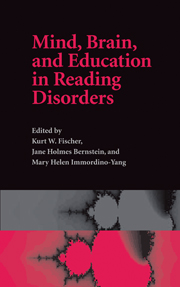Book contents
- Frontmatter
- Contents
- List of figures
- List of tables
- List of contributors
- Acknowledgements
- Part I What is Reading, and What are Reading Disorders? Looking to Neuroscience, Evolution, and Genetics
- Part II Reading and the Growing Brain: Methodology and History
- Part III Watching Children Read
- 10 Finding common ground to promote dialogue and collaboration: using case material to jointly observe children's behavior
- 11 Analyzing the reading abilities of four boys: educational implications
- 12 First impressions: What four readers can teach us
- 13 Analysis of reading disorders from a neuropsychological perspective
- 14 An educational/psychological perspective on the behaviors of three children with reading disabilities
- Part IV Reading Skills in the Long Term
- Appendix: Transcript and behavioral data from Profiles in Reading Skills (Four Boys)
- Index
- References
13 - Analysis of reading disorders from a neuropsychological perspective
Published online by Cambridge University Press: 22 September 2009
- Frontmatter
- Contents
- List of figures
- List of tables
- List of contributors
- Acknowledgements
- Part I What is Reading, and What are Reading Disorders? Looking to Neuroscience, Evolution, and Genetics
- Part II Reading and the Growing Brain: Methodology and History
- Part III Watching Children Read
- 10 Finding common ground to promote dialogue and collaboration: using case material to jointly observe children's behavior
- 11 Analyzing the reading abilities of four boys: educational implications
- 12 First impressions: What four readers can teach us
- 13 Analysis of reading disorders from a neuropsychological perspective
- 14 An educational/psychological perspective on the behaviors of three children with reading disabilities
- Part IV Reading Skills in the Long Term
- Appendix: Transcript and behavioral data from Profiles in Reading Skills (Four Boys)
- Index
- References
Summary
Overview: Uncovering the true nature of dyslexia requires more research on the relation between environmental and neurological influences on the development of reading. One factor that complicates diagnosis of core deficits is children's use of compensatory strategies to deal with task demands. To get around this problem, Taylor suggests focusing on basic cognitive abilities, making connections between children's cognitive weaknesses and their possible neurological deficits. For example, he suggests that the child William's difficulties with copying the Rey-Osterrieth Complex Figure and with sequencing items may stem from problems with executive function and deficits in frontal lobe processing. This approach hones in on deficits and the separation of children's primary neurological problems from the complex effects of environmental influence and individual compensation.
The EditorsThe snapshots of behavior and task performance seen in the videotape segments document wide-ranging differences between children with normal learning abilities, such as Jonathan, and students with learning problems. These segments also demonstrate the variability in learning problems and associated cognitive and behavioral traits present within even a small sample of children with reading disabilities. The divide between normal and disabled is by no means unidimensional.
However, children with reading disorders also have characteristics in common. One of our assumptions about the boys with reading disabilities is that they have had chronic and relatively intractable problems in learning to read.
- Type
- Chapter
- Information
- Mind, Brain, and Education in Reading Disorders , pp. 227 - 242Publisher: Cambridge University PressPrint publication year: 2007



